Story by Chris Hector
Last month we charted Chris Chugg’s rise to the top and the two horses that took him to compete in the World Cup finals in Europe – the stallion, Sky High and the gelding, Mr Currency. Chris’ next star was a mare:
“My next great horse was WS Scandal who was owned by Pete and Caroline Wagner. Pete used to jump the mare in the D-grades and he rang me up and said, ‘I’ve got this great horse but it’s jumping me off. Can you come and have a look at it?’ And I’d just been to, I think, Harry Hall and got a brand new tweed coat made up and I had RM Williams moleskins on. I looked like some wanker from the showground coming up to buy a horse on Saturday, the sort that it’s really unsafe to show a horse to.”
“Pete free jumped her for me over two 1.40m oxers in a double on one stride. I thought if a horse could jump like that with a rider on you’d need to teach it nothing because it jumped in perfect technique, perfect shape. So we took her down the back and I gave her a couple of jumps then I took her home. Scandal ended up qualified for the Atlanta Games, as a six-year old.”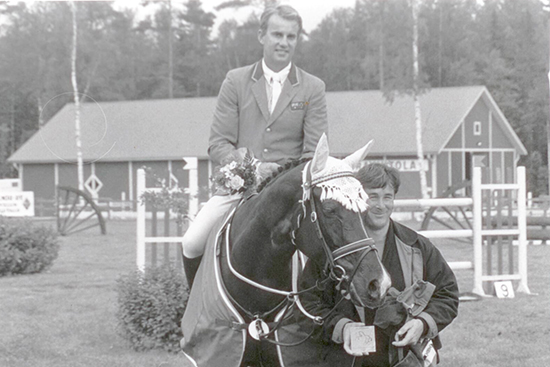
Early days – Chris and Scandal with Peter Wagner who found the mare…
But sadly you never got the chance to compete her at the top…
“No, because at that stage she was the only horse that qualified at Falsterbo – but she only qualified a place for an Australian representative at the Games. Pete and I spoke to the selectors and we said can you guarantee that if this horse stays sound and in form that she has the position that she’s earned. And they said, ‘No, she has to come back home to Australia and compete against all the others.’ So that made it easy, the mare was on the market. We brought her home and campaigned her for a little bit and Princess Haya came to Australia and tried her. She had seen a video-tape of the mare at Wiesbaden and said, ‘I love that mare where is it?’ – ‘Oh, that mare’s gone back to Australia’. So she flew out to look at her and bought her.”
By this time you’ve got a business going here in Australia; you’ve met Helen.
I met Helen in the early days of Sky High. I was 21 and Helen was 20. Helen moved up to Glossodia with me. I was an apprentice farrier down at Sydney Showground. I used to work out of Terrey Hills and Helen had her horses at the Sydney Showground – I used to go over there and do a bit of work two days a week and that’s how I met Helen. Helen actually happened to be hanging on to Diamond B Ego’s mother, Bundara, a mare that Tony Norman used to show jump. Helen was helping out in the stables at the time and holding Bundara while I was clinching her. So we met that day…”
“Years later Tony Norman rings Helen, he still owned Bundara, and said that he wanted to go to the WEG at Stockholm and he needed to sell the mare to buy his ticket. ‘Do you want to buy the mare?’ and of course we did. We had a history with the mare and, and we bred Sky High II and Diamond B Ego out of her, and Temptation, who is the mother of Vigo, the mare I ride now in the World Cups. Vigo’s got too much blood to be totally trainable, so she’s work-in-progress, but her heart’s always in the right place, lots of scope. We give her another three years before we expect her to really shape up. I’m lucky enough to have Michelle Barrera’s mare, Alondra, to ride at the moment in the World Cup, so that takes a lot of pressure off the other mare.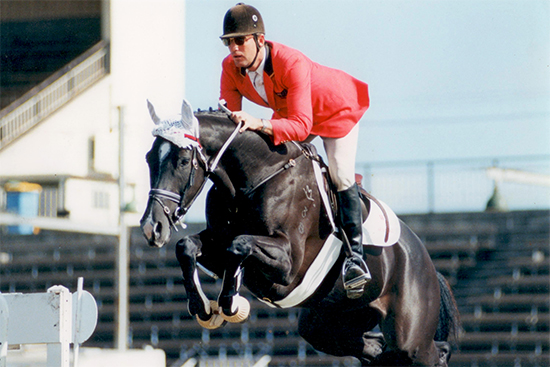
What a jump! Chris and Scandal in full flight!
So when did you meet up with George Morris?
“I did a clinic with Sky High with George before I went to the World Cup finals. Then when I was at Schockemöhle’s, he brought George Lindeman who’s very famous for a lot of things and another American rider to Paul’s place to try horses. I was doing the take-off and landings in a small indoor arena where the two fences are and those two fences are the biggest fences I’ve ever seen in my life and they had Clydesdale horseshoe cups – the rails sat in the Clydesdale horseshoes.”
“That’s where mountains were jumped and George had them trying about 20 horses, because George Morris’s favourite way of getting his young riders who have got eliminated or crashed on a Saturday/Sunday in the Nations Cup operating again, is to go around and try horses at all the dealing yards, so their horses have a rest.”
“After a while, Paul said, ‘Okay, I have a restaurant down the road. We’ll all go to lunch and we see if we can do some business and slap hands.’ I was just keeping on working and George Morris turned around and said, ‘Oh, make sure Chuggy comes’. Paul didn’t know that I knew George Morris. And he said, ‘Why does he come?’ ‘Because I know him. He’s a good Australian guy, I teach him in Australia. He must come.’ Paul was amazed.”
“So I put the rake down, it was the first decent meal I’d had the whole time I’d been there, especially meat and it was a great lunch. George offered me a riding career, ten Grand Prix horses and a very fast car. I said, ‘No thank you, George, but I appreciate the offer.’ But, you know, George has been my biggest influence in my life because he teaches nothing that you can’t use in the ring.”
“There’s no quick fixes, it’s just correct, repetitious, and if you work with the horse, the horse works with you. It makes your job easy.”
“He came out and he built some courses at Castle Hill one year when I had Sky High.
We had said, ‘Can you just build us something that we’re going to face overseas?” So he built two tracks and I won both of them and I said, ‘What do you reckon about that, George?’ And he said, ‘You’ve won the battle but you’ve lost the war.’ It wasn’t the way he wanted me to ride. It took me probably ten years to work that one out. He never explained it, and I was a bit funny about it for a while, and then I learnt what he meant. He wants it done in a style that creates the future of the horse. You can win Saturday and Sunday but can you win next week?”
“That’s something that I’ve learnt to do, to appreciate the horses that I have, and save them for the classes that I want to win. And that’s created a great business for me because I’ve trained the horses to a level that are very marketable. I never had a horse in my life that stopped and I’ve never sold a horse in my life that’s stopped.”
“And there’s a very big market for horses like that. With Currency and with Scandal and with Vivant, I’ve only ever had great phone calls from the new owners and the horses have had great futures. It’s like an apprenticeship you go through and you realise that you get paid for the work that you do in this sport, and it’s not always financial, but it’s sometimes it comes back in just having great partnerships with horses.”
You and Helen were amongst the first of the showjumpers to get serious about breeding and bloodlines…”
Helen chimes in: “We couldn’t afford to buy them, that’s why.”
Chris takes up the story: “After Currency it took me ten years to get another ride on a horse that was at that level, which was Scandal.”
Helen: “It was only about four years, sorry.”
Chris: “Well, it felt like ten years. The Thoroughbred industry was breeding smaller and smaller downhill two-year old sprinters and we were losing the lovely big types of big Thoroughbreds, although saying that the horses that I had were not big – 10-stone hacks: Scandal was a 10-stone hack, Currency was a 10-stone hack. But you were not able to find horses that were coming off the track that you could purchase for $1,000 or $2,000 and you could take home and try them and when you x-rayed them they weren’t full of chips or navicular or pedal bone problems or … and they could canter up hill and they hadn’t been jiggered or chased up. So we said, right, we’re going to have to go to Europe, and buy a horse that’s got all those three horses in it. It’s got Sky High, it’s rideable, its got Currency and Scandal and its got instinct. Buy something that’s going to improve the Thoroughbred mare so we can sell services, breed eventers like Shane Rose’s Virgil.” (Shane’s Virgil is by Vivant)
“We needed to produce horses that if they’re not 1.50m horses, they’re 1.30m horses. Horses that suit the amateur market, so they’ve got great canters, great characters, good types, types are important. We didn’t want a chestnut, hard to sell chestnuts. We didn’t like the Holstein lines, we didn’t appreciate them then, and we don’t like diesels. We want a horse that has its natural carriage in walk, trot and canter and then when Vivant came out he was just one of those horses.”
“He was just turning three when we bought him, he looked like a young Thoroughbred stallion. He just stood there. He was uphill, he was beautiful. I actually chose a different one and Helen chose him. He was three; the other horse was four and had had 12 months training. And the other horse was Grannus blood and we follow the bloodlines pretty well, and lovely horse that Grannus was, I’ve actually ridden him at the Klatte Stud, but he had characteristics that wouldn’t suit u the Australian Thoroughbreds in his style of jumping, and conformation-wise. Still the Grannus we saw appealed to me, but I wanted something that was a bit easier to ride, and while I could see myself riding the Grannus, and he was a nice jumper, he didn’t come up through the wither enough. He just used his shoulders, plus he was a chestnut.”
“So it was back to the other one. The breeder said the horse has never been ridden outside. He’d never been jumped under saddle, only been free jumped. So the daughter’s 16-inch saddle came out, the big fat girth came out, and it didn’t fit him. The breeder grabbed his ear and grabbed a handful of muscle, and he’s got hands like a pig farmer, the horse stood there squealing as I got on him and then he just let me go.”
“It was a concrete yard that had a foot of snow on it. We put a cross rail in the middle, the saddle was slipping sideways. My son Nick was laughing sitting on the rail. It’s minus five, the saddle’s fallen to one side, they don’t drive them over there, so they have no mouth. But Vivant was very good on touch, you could touch him on the neck and he’d stay straight. So I touched him by the neck, stock-horse style, to keep him straight.”
“He came up to the cross rail and he jumped it at the trot, beautifully. We put two cross-rails together to make an oxer and he’s come down and he’s jumped it that big that I’ve had to lean back thinking the saddle’s going over his head because the girth is so loose. Amazing jump. I said to Helen, ‘Can we make it a big bigger?’ She said, ‘What more do you want to see?’ I said, ‘I didn’t get to see it, I was just scared of landing.’ It was like landing off a drop fence in cross-country.
Helen: “I said, ‘We’ll take him.’ We didn’t need to see more.”
So what did you pay?
Chris: “Good money. He was cheaper than the one I just bought, that’s for sure. And yeah, I can tell you how much I paid for my new one, 142,000 euros.”
“When we first went to Europe to buy horses, we went across with a view that we weren’t going to bring a single horse home that didn’t tick all the boxes, as in free jumping and our instinct when I rode it. I didn’t buy anything for the riding team that we didn’t ride. All the ones that weren’t broken in, got broken in and I went back and rode them ten days later. So they were wild rides, but I would rather see a horse have its first jump and see how it handles its shoulders and how its instincts are. I trot the fences over there, you’re riding green horses that can’t canter, or they can canter but you can’t steer them. So I do a lot of trotting. I trot into cross rails – and they think I’m crazy – and I hang onto the mane and I get in a very small indoor arena and I just go backwards and forwards.”
“We were on the train, we never had a car in those days. So we were on a train and we would do our videoing, review the videos. We’d do the vet checks. We would do our next interview. We would go from Germany to Belgium to France. We’d ring them, they’d come and pick us up off a train station, drop us back on a train station. We did six weeks of travelling around Europe by train. We came back with four horses from that trip: two brood mares, Vivant and Alondra.”
So how long before you got Vivant out and started competing with him?
Chris: Oh, I think Amanda Madigan was the first one to jump Vivant at home. I might had been away and when I came back Amanda had been working him and I said, ‘Okay, give me a look at him jump’, and she jumped him for me and then I said, ‘Right he’s mine.’ He won the four-year old jumping class at Dressage and Jumping with the Stars – it was his second ever start. He had a start the weekend before in the Equitation Championships, because that was all that was on, and then went down to Werribee and won there.”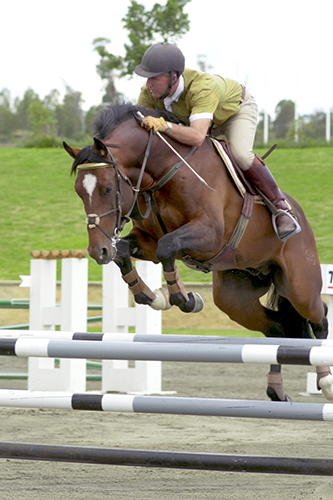
Vivant competing as a youngster competing in the Futurity
How long before you got him up to Grand Prix?
“Eight. He injured himself as a seven- year-old, and had a year out. We had Conquistador by then and he covered Vivant’s mares for that season. That’s how we have the double-cross, we’ve got mares that are by Vivant out of Conquistador mares, or by Conquistador out of Vivant mares.”
Did you ever give up in that year that he was out?
“I was away teaching. And when I came back, Amanda said, ‘I rode him yesterday and he was sound. I rode him the next day and he was unsound behind, like he couldn’t carry the leg, so I got off him.’ But we couldn’t pin down what was wrong. I’d get the vet out and vet would look at the horse and say, ‘No, he’s fine. He trots up fine.’ But there was something wrong, and we put it down to trying to gallop in the yard and falling arse-over-head sideways like foals do.”
“Unfortunately Vivant couldn’t lay down with his injury and it was a 40-degree u summer, Christmas. Shocking weather we were having. We’ve got a very big ironbark tree outside the stables, and the stables were so hot, and he had to be confined so we had to tie him up under the tree, because he’s a reckless, cheeky bugger. He loved to roll. He’s one of those horses that when he did roll he would roll six times from one side to the other without getting up.”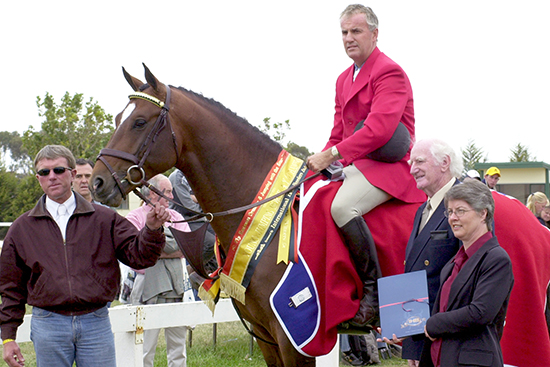
Champion in the Young Jumping Horse classes at Dressage with the Stars, with judge, Kiwi international, John Cottle and sponsors Eli Klingma and Glenis Dyason of IHB.
“That’s a characteristic we look at because Currency was the same, Scandal was the same, Sky High was the same. They could actually roll from side-to-side without having to get up and change sides. So we tied him to the tree for nearly six months. He wasn’t allowed to lay down for six months, and we knew that if he did lay down it was going to be detrimental to him, so he was hobbled and tied up short, hosed down every couple of hours, looked after. He was always part of the barbecue.”
“One time we had an 18th birthday party going on, and I had forgot he was only 20 feet away, and I’m a great one for bonfires with 20 litres of petrol and 20 litres of diesel, and this was about eight o’clock at night when the party was raging and I forgot that he was tied to the tree and I’ve made a fire of about at least 15 tons of heavy timber and I’ve decided to light it halfway through the party and have a great time.”
“When it blew up, Vivant’s standing there, we can see him in the background, just standing there looking. And I thought, wow, I even forgot that he was there, but he is so cool. He always wanted to be part of everything. So he had 12 months off, and Helen looked after him and managed him and he came back 100%…
We were very lucky.”
You just missed out on the team for the Beijing Games…
“I did a clinic with George Morris with the horse when he was six years old and George made one of his predictions, “I’m going to see this horse at the next World Championships.” In the lead up to the Beijing Games, we did Sydney Royal because it is such a good preparation, and secondly, we had commitment to clients and everything else that goes with it. Sydney Royal is a show where you can win $10,000 -$14,000. And to win that sort of money at a show is like winning ten World Cups. Well, I won five World Cups with Vivant and I think I won $6,000 all up. Plus the horse was still doing his stud season. So I left it a bit late getting to Europe, but in saying that, I don’t think it did the horse any harm not being asked to go to Hong Kong and be a team’s horse.”
“It was a shame how the selectors had to choose the horses, their criteria. Because had they had a wild card option for Vivant, I think he would have been a great team member and probably we would have had a better result than what we had. Although we had a fantastic result with a great team of horses there, I think that it was a loss of the horse not being in the team and myself, for sure. But it made Kentucky two years later, so much sweeter.”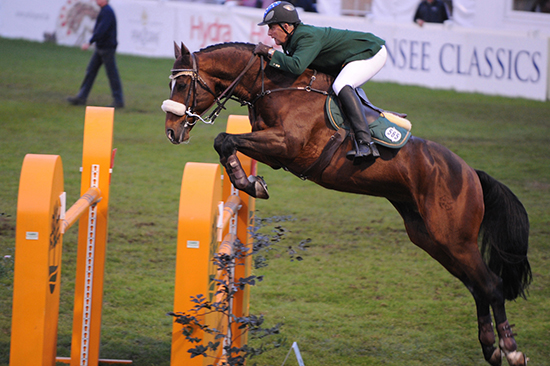
The one that got away! Vivant and Chris at the selection event in Aach for the Beijing Games – they went well at this trial but a poor run at the first trial put them out of the team
In the run up to the Kentucky WEG, you went to the World Cup final, you’d been to two World Cup finals before, and suddenly it all started to click at the third one…
“We were just at the right training phase of his career for me to ask more questions. He had had such a good four years at home being asked not too much, but enough. He was ready for the tougher challenge, to go to five star. Five star is just more ground speed and bigger fences, a fancier arena, better course builders, more pressure as prize money gets bigger, and more pressure having the best 25-30 horses in the world chasing you down. It made the horse peak. And it was no shock to us that he peaked, just a breath of fresh air. It was the end of all the time that we’d put into him since we found him as a three-year-old. We’d seen him grow and seen that our program worked, our horse selection worked. It can be done. You can go and buy a great young horse and turn it into an international horse. And you can do it from Australia.”
At what point in that World Cup final did it suddenly start to sink through to you, Hey, I can top ten this one?
“Part of the problem was even getting to start. Vivant had a talent for trouble and there was never anything he went to that there wasn’t a hiccup. On the way we stopped at Basel. The guy who does all the paperwork for the equestrian horses to go across the border said that he had a good stable for us to stay in. Well, that stable had a brood mare foaling that night next door. We said, ‘That stable’s not suitable, we can’t stay there.’ He said, ‘I have a stable over here but it has a big concrete window.’ So I taped up the concrete window with electric tape so he wouldn’t go near it. Somehow during the night he managed to pull the electric tape down, jump out over the window, hang on the window on his stifle then get out. Our truck was ten feet away and at midnight we got a phone call to say, ‘Your stallion is out and he’s in the stallion barn with the six other stallions fighting over the doors.’”
“We jumped out bed and we find Vivant standing in the stable block holding one leg up like a castrated colt. He’s got blood hanging out of his stifle and we walked him and he was sound, and we trotted him and he was lame. He was 90% hopping lame, like a horse that had just been castrated. I had to drive the next day and we had driven all night to get there, so Helen said, ‘You go back to bed. I’ll tie him up to the brick wall and I’ll keep the cold hose on him.’ It was so cold the water was so freezing cold out of the tap.”
“So Helen sat outside from one o’clock in the morning until seven in freezing conditions hosing him down. What Helen did took all the inflammation and the pain out of the horse. We were going to turn around and come home, but we had a dozen Australian friends who had flown into Geneva to see the horse – and to get our World Cup funding money we had to actually front up in the trot-up. Okay, so we’ll go, but we’re not going to show a lame horse in the trot-up.”
“We were four days from the trot-up because we wanted to get there early. He hung himself up on the Sunday night so we had from Monday until Thursday lunchtime to get him right.”
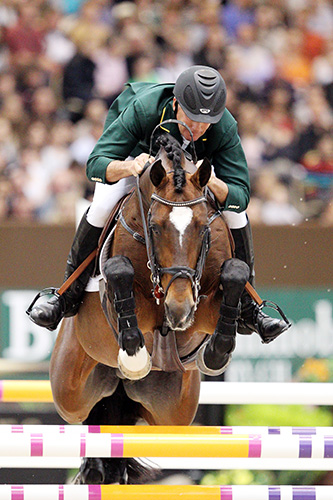
“George Morris was great, he said, ‘How you going, Chuggy?’ I said, ‘Oh, I’m not starting.’ ‘What do you mean you’re not starting?’ I said, ‘He’s too lame to start.’ He said, ‘Bring him out and we’ll have a look at him.’ So I brought him out and he looked at him and he said, ‘He doesn’t look that bad.’ He said, ‘I’ll get our vet to have a look at the horse for you to make sure he hasn’t broken anything.’ The vet brought his portable scan machine and said, ‘Look this horse has just done a bit of fibrous soft tissue damage, he’s bruised, but he’s probably going to be fantastic in four days.’ So we ice-packed him. Edwina Alexander loaned me a vibrating machine and a blood circulation machine.”
According to Helen everyone was supportive: “They all knew the situation… everyone knew about the Australian horse. All the trot-up vets knew, and they could not have been nicer. The chief stewards, they’d come every day and say how’s he going and when we presented the horse for trot-up and he trotted up sound, it wasn’t only us who was happy. You know, the people over there are so wonderful and so accommodating.”
The amazing thing is that Vivant came right so quickly…. Even Chris was surprised:
“I didn’t get to ride him for five days, and I took him out on the morning of the speed class, cantered him over two cross-rails, and he felt fine. We gave him an hour off and we trotted him up again, he was perfect. For the speed class I had a plan, I walked the course, and asked George Morris about it. He said, ‘Well, do what you want to do.’ So I rode a nice round, a really happy round with the horse because I thought this would probably be my last start, I wouldn’t get into the second day this would be it. And the horse was fabulous, we made it to the next round.”
“The next day the horse was very confident, jumped great. I made a mistake going into a Liverpool oxer combination and the horse didn’t really have enough time in there to get his distance out and he had it down. The next round we jumped the same fence back to front and he jumped it fantastic. So every day was a learning curve and then I realised that I had a really good chance to make the final …”
The pair not only made the final, they ended up in 7th place, the best placing ever for an Australian combination…
This article first appeared in the April 2012 issue of THM.
For more articles with Chris Chugg, go here:
